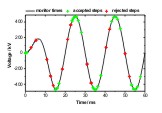German Research Foundation (DFG) Approves Collaborative Research Centre
German Research Foundation (DFG) Approves Collaborative Research Centre
Based on two simulation codes for full space-time adaptive magnetic field computations, MEQSICO (Magneto-/Electro-Quasistatic SImulation COde) and KARDOS, which have been newly developed and further developed respectively, and simulations for typical transient benchmark problems, such as the TEAM 7 problem and the SRC disk read-write head, the following results were obtained:
With these results, an important step has been made towards robust and efficient time-domain simulations for complex two- and three-dimensional magnetic field problems. A subsequent transfer of the published empirical values into future simulation tools is possible and allows there a user-friendly simulation of transient magnetic fields.

ISBN: 978-3-540-69776-3